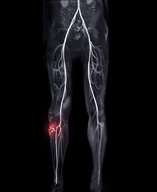Use of 4-PBA for the Prevention and Treatment of Vascular Lesions in CM-AVM
TECHNOLOGY NUMBER: 2020-058

OVERVIEW
Discovery that BV and LV lesions in CM-AVM result from an inability to export collagen IV- The chemical chaperone 4BPA can permit proper folding and therefore exportation of collagen IV
- May be capable of delivery to at risk patients when they are young, or even in utero
BACKGROUND
Capillary malformation-arteriovenous malformation (CM-AVM) is an autosomal dominant blood vessel (BV) and lymphatic vessel (LV) disorder that results from combined germline and somatic mutations of the RASA1 gene in BV endothelial (BEC) and LV endothelial cells (LEC). While BV and LV lesions are commonly present at birth, they may develop throughout childhood and even into early adulthood. CM-AVM is characterized by cutaneous CM with one-third of patients also having fast-flow vascular lesions, which may become life-threatening depending upon their anatomic location. LV abnormalities may cause lymphedema, chylothorax, or chylous ascites in a smaller number of these patients. While some genetic predispositions such as mutations of the RASA1 gene are known to correlate with the incidence of CM-AVM, a robust knowledge of this disorder remains unclear. So, a need exists to further understand the pathogenesis of and potential corresponding treatment avenues for patients with CM-AVM.
INNOVATION
Researchers have discovered in a mouse model that blood vessel (BV) and lymphatic vessel (LV) lesions in capillary malformation-arteriovenous malformation (CM-AVM) arise as a consequence of an inability of blood vessel endothelial cells (BEC) and lymph vessel endothelial cells (LEC) to export collagen IV. Collagen IV is an essential component of vascular basement membranes, and the inventors found that administration of the chemical chaperone 4-phenyl butyrate (4BPA) can restore the ability of BEC and LEC to export collagen IV, thereby preventing the development of lesions associated with CM-AVM. The mechanism increasing collagen IV exportation relates to its ability to more properly fold and release from endothelial cells in the presence of 4BPA. One could envision this type of treatment being administered to a disease carrier of any age, even potentially being given in utero. This novel approach therefore shows promise in the research and treatment of patients with CM-AVM.